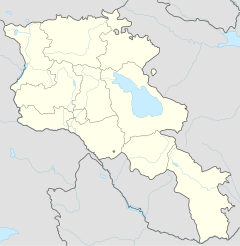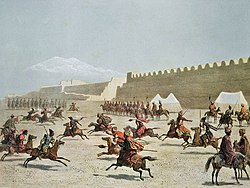Armavir (Armenia)
|
Armavir Արմավիր |
||
| State : |
|
|
| Province : | Armavir | |
| Coordinates : | 40 ° 9 ′ N , 44 ° 2 ′ E | |
| Residents : | 26,387 (2008) | |
| Time zone : | UTC + 4 | |
| Community type: | city | |
| Mayor : | Davit Chudatjan ( civil contract ) | |
| Website : | ||
|
|
||
Armavir ( Armenian Արմավիր ) is the capital of the province of Armavir in the west of Armenia .
Names
Armavir was during the socialist period to 1992 Hoktemberyan, Hoktemberian or Oktemberyan ( Armenian Հոկտեմբերյան Hoktemberjan ) and before 1932 Sardarabad, Sardarapat or Sardar-Apad . The city of the same name Armavir in Russia was founded in the 19th century by Armenians from Armavir.
Population numbers
In 1989 the city had 46,900 inhabitants, but the number of inhabitants fell noticeably: the 2001 census shows 32,034 inhabitants; for 2008 there are an estimated 26,387.
history
Antiquity
Armavir has been around since the 5th or 6th millennium BC. Inhabited. Obsidian artifacts and pottery from the period have been found. King Argišti I of Urartu built a fortress in the area and named it Argištihinili.
Moses of Choirs
Moses von Choren (5th century) reports that King Vaharschak himself died in 149 BC. He settled in Armavir, built a temple there and asked his favorite, the Jew Shambu Bagarat (Bagratiden), to give up his religion and worship idols. Shambu refused the order. Moses von Chorene claims that in Armavir, and later in Bagaran and Artaschat, images of the sun and moon as well as of the Arsakid ancestors were worshiped. He also writes that Tigranes II , whose reign he was 90–36 BC. Sending an expedition to Palestine to take revenge on Queen Cleopatra VII of Egypt, capturing large numbers of Jews and settling them in Armavir and Vardges. Modern historians do not believe that Tigranes II was alive when Cleopatra VII became queen of Egypt. Moses goes on to say that the Jews were later brought from Armavir to Ernanda and were again relocated to the new capital Artashat under King Artaxias I , whom he settled at 85-127. From there, Shapur II of Persia is said to have deported 30,000 Armenian and 9,000 Jewish families when he invaded Armenia in 360-370; Artashat was completely destroyed.
Clay tablets from the Achaemenid period were discovered which contained episodes of the Gilgamesh epic in Elamite . When in 331 BC When Armenia gained independence from the Achaemenids under the Orontids , Armavir became the capital of Armenia. Various inscriptions in ancient Greek from the 3rd century BC. BC contain poetry by Hesiod , plays by Euripides , a list of Macedonian months and names of Orontid kings. Armavir was conquered by the Seleucids , Parthians , the Kingdom of Armenia, the Roman Empire , the Sassanids, and the Byzantine Empire until the Arabs captured it in 645.
Medieval Armavir
Arab supremacy lasted until the first quarter of the 9th century. The Sajids administered the region in the 9th century. After that, the Bagratids ruled here .
The Byzantine Empire conquered the region in 1045, but lost it to the Seljuks in 1064 . The Seljuks renamed the city Serdarabad . The region was held by the Georgians, the Atabegs of Azerbaijan and the Khorezm Shahs after the collapse of the Seljuks . The Mongols took the region in 1239 and founded the Ilchanate in 1256 . Armavir came to the Chupanids in 1353 , to the Jalairids in 1357 and to the Qara Qoyunlu in 1388 . Timur conquered Armavir in 1400. Qara Yusuf took it back from the Timurids in 1407. Nevertheless, the Timurid king Shah Ruch captured the region in 1421 and 1429. Jahan Shah , who was a ruler of the Qara Qoyunlu, conquered it in 1447.
Pre-Russian Armavir
The rule of the Qara Qoyunlu lasted until their defeat by Uzun Hasan in 1468. Uzun Hasan was the ruler of the Aq Qoyunlu , the arch enemies of the Qara Qoyunlu. Ak Qoyunlu's rule lasted until 1501 when Shah Ismail conquered the city. Ismail was the founder of the Safavids . Armavir was conquered by the Ottomans several times in a short time in 1514, 1534, 1548 and 1553. The Ottomans conquered it again in 1585, but Abbas I brought Armavir back in 1603. Armavir was then reoccupied by the Ottomans from 1635 to 1636 and 1724 to 1736. After Nadir Shah's death in 1747, it became part of the Yerevan Khanate , a Muslim principality under the influence of Persia.
Russian domination
The reason for the Russo-Persian War of 1826-1828 was that Persia wanted to recapture areas that it had lost to the Russian Empire between 1804 and 1813 . First, the Persians pushed the Russians out of Azerbaijan in 1826. But the Russian general Ivan Fyodorovich Paskevich not only recaptured Azerbaijan, but also occupied the Yerevan Khanate in 1827. With the Treaty of Turkmanchai in 1828, this area around Armavir officially passed into Russian ownership. Armavir became the Ujesd Serdarabad of Armenia Oblast , which in turn became the Yerevan Governorate in 1850 . This remained so until the February Revolution of 1917 .
In 1902 the section of the Tbilisi – Yerevan railway line , on which Armavir is located, began operating. Its station is no longer served by passenger traffic today.
The 1917 Revolution and the Armenian-Ottoman War
After the February Revolution, the region was under the control of the Special Transcaucasian Committee ( Russian Особый Закавказский Комитет ) of the Provisional Government and subsequently part of the short-lived Transcaucasian Democratic-Federal Republic .
After the dissolution of the Transcaucasian Democratic-Federal Republic in May 1918, Armavir became part of the Democratic Republic of Armenia and then played an important role in Armenian history because of the Battle of Sardarapat. In the battle, Armenian troops repulsed the Ottoman army, whose campaign in the Caucasus was aimed at taking Yerevan.
Nevertheless, the Ottomans had occupied most of the Yerevan Governorate, so that the Armenians had to agree to the Treaty of Batumi in June 1918 . The Ottoman Army later withdrew after the Mudros Armistice was signed , and Armavir became part of the Democratic Republic of Armenia again in November 1918.
Soviet Armavir
On November 29, 1920, the 11th Red Army marched into Armenia. The Bolsheviks took Yerevan on December 4, 1920 after the Democratic Republic of Armenia had signed the Treaty of Alexandropol . The contract was replaced by the contract of Kars . The Bolsheviks proclaimed a Soviet Socialist Republic in Armenia under the leadership of Aleksandr Miasnikyan. This was then incorporated into the newly created Transcaucasian SFSR in 1922. The name of the city was changed from Sardarapat to Hoktemberyan / Oktemberyan in 1935.
Two years after Armenia proclaimed its independence from the USSR , the name of the city was changed back to Armavir in 1992.
Sports
- Araks Armavir (football club)
See also
swell
- Adolf Baumgartner : Armavira . In: Paulys Realencyclopadie der classischen Antiquity Science (RE). Volume II, 1, Stuttgart 1895, Col. 1179.
- Names Search Results for Armavir - National Geospatial-Intelligence Agency
- Census for Armavir on page 6 (PDF file; 756 kB)
- World Gazeteer: Armenia - World-Gazetteer.com
- Brady Kiesling, Rediscoving Armenia on p. 37 ( Memento from March 25, 2009 in the Internet Archive ) (PDF file; 1.72 MB)
- Armavir (Armenia) . In: Ehsan Yarshater (Ed.): Encyclopædia Iranica (English, including references)
Web links
Individual evidence
- ↑ https://armenianweekly.com/2018/10/24/pashinyan-calls-loss-in-kapan-a-win-for-democracy/ (accessed January 4, 2020)
- ↑ P. Calmeyer / U. Seidl, an early Urartian representation of victory. Anatolian Studies 33, 1983 (Special Number in Honor of the Seventy-Fifth Birthday of Dr. Richard Barnett), 107
- ^ Jewish Encyclopedia , Vol. 1, pp. 116-17.
- ↑ 2016 timetable of the Armenian Railway .

